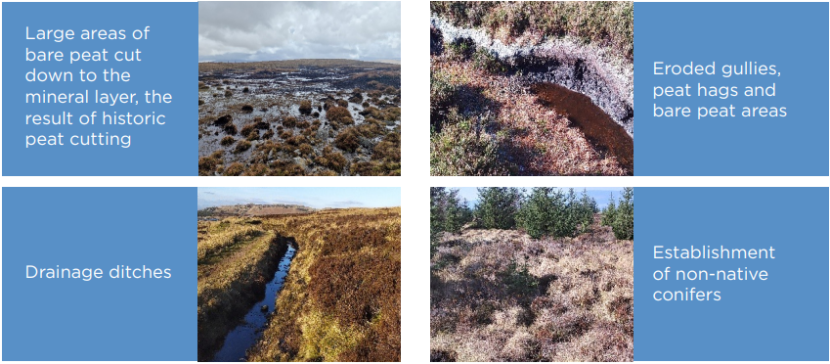Natural Capital Assessment Template - Case Study - Peatland restoration

Background
An estate in the north of Scotland undertook a variety of measures to restore an area of peatland in order to reduce carbon loss, increase carbon sequestration, enhance peatland ecosystem functions and make the site more resilient to climate change with advice from a specialist Peatland Action advisor.
There was an area of degraded peatland, with a number of issues including:

- Large areas of bare peat cut down to the mineral layer, the result of historic peat cutting
- Drainage ditches
- Eroded gullies, peat hags and bare peat areas
- Establishment of non-native conifers
This peatland restoration project was funded mainly from the NatureScot Peatland ACTION fund, with financial and in-kind contributions from the estate.
Approach
Peatland habitat was restored by:
- Blocking and re-profiling ditches.
- Re-profiling, stabilising and re-vegetating areas of bare or badly eroded peat.
- Removing non-native conifers.
Cost and benefits
The financial cost of the peatland restoration project was supported using the NatureScot Peatland ACTION fund, with financial and in-kind contributions from the estate.
The carbon emissions reduction of the project has been calculated using the methodology developed for the Peatland Code and the Peatland Code Emissions Calculator. The valuation of the reduction in carbon emissions (in tonnes of CO2 equivalents) can be either based on the non-traded price of carbon (i.e the shadow price of carbon that is used in government project), or the traded price of carbon, which is currently much lower.
Below shows the costs and benefits on a per ha bases, based on an assumed project duration of 50 years and no leakage (increased emissions on the Estate as a result of displacement of land management activities due to the restoration).
|
Annual Marginal Costs |
Per Hectare (£) |
|---|---|
|
Restoration costs amortized over 50 years at 4% |
33.65 |
|
Fees amortized over 50 years at 4% |
1.68 |
|
Total |
35.33 |
|
Annual Marginal Benefits |
- |
|---|---|
|
Using non-traded price |
150.72 |
|
Using traded price |
12.51 |
|
Total using non-traded price |
150.72 |
|
Total using traded price |
12.51 |
|
Annual Marginal Cost: Benefit (non-traded) |
115.38 |
|
Annual Marginal Cost: Benefit (traded) |
-22.83 |
Challenges
There is insufficient data available to measure and value other material impacts in terms of: water quality regulation; soil quality and erosion regulation; and wild species diversity, nor other benefits relating to livestock production, wild food (game), flood regulation, recreation and education.




